
Surveys
DJC.COM
November 15, 2001
Rebirth of a Commencement Bay chateau
Merritt+Pardini Architects
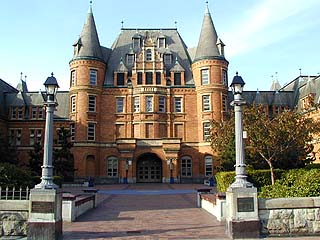
Photo courtesy of Merritt+Pardini Architects Tacoma’s Stadium High School was built by the Northern Pacific railroad as a tourist hotel in 1891.
|
The decision reflects the community’s growing interest in retaining and modernizing old structures, which has been incorporated in the Tacoma School District’s program for renovation and new school construction.
With its majestic French chateau architectural style and location on a bluff 240 feet above the shoreline of Commencement Bay, Stadium High School is a widely-recognized and beloved landmark in the Tacoma community and surrounding region.
Dramatic history
While it operates today as a school, Stadium takes pride in a colorful and dramatic history.
Originally built as the Northern Pacific Railroad Tourist Hotel in 1891, construction was slowed by an economic downturn, then halted by a fire that gutted the building. The remaining structure was eventually acquired by the Tacoma School Board, which hired Hewitt Architects to rebuild it as a school.
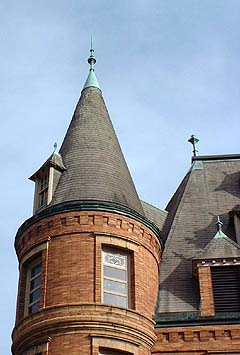
Photo courtesy of Merritt+Pardini Architects The exterior of Stadium High is in good shape, including its copper finials on its turrets and dormer windows.
|
The picture of a French chateau that the firm submitted to the board as its proposed design hangs today in Stadium’s main office.
A few years after the school opened in 1906, a huge athletic bowl was cut into the bluff adjacent to the school. It was constructed in the style of a Greek amphitheater, with a field of 2.5 acres and 31 levels of seating. While home to the school’s sports activities and teams, it has also served as a forum for important civic and community events — ranging from gladiator games and chariot races to appearances by sports idols, war heroes and presidents.
The school district recently selected two architectural firms known for their expertise in historic restoration and school construction to undertake the renovation of Stadium.
Merritt+Pardini Architects’ experience includes the historic renovation of Jason Lee Middle School and the Rialto Theater in Tacoma, while Bassetti Architects’ experience includes several new high schools and the historic renovations of West Seattle and Franklin high schools in Seattle. The two firms previously collaborated on the renovation of Tacoma’s Union Station, which dates from 1911.
As with any project that involves a historic building, significant challenges await the team.
The renovation
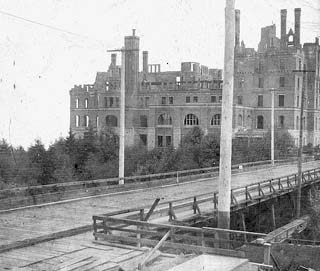
Photo courtesy of the Tacoma Public Library A turn-of-the-century photo shows construction of Stadium High School. |
The exterior masonry walls, the only original part of the structure, are 5 feet thick at the base and 18 inches at the top, and iron bands encircle the foundation and every floor. The renovation work will have to take into account the numerous modernizations over the years that have replaced many of the original interior and exterior features.
“Schools projects are usually one of three types: preservation, restoration or new construction, but Stadium will incorporate all three,” says Lee Pardini, Merritt+Pardini’s principal in charge. “The interior will be more challenging because so much has been changed in the past 95 years, including floors, windows and stairways.”
There is little millwork and trimwork left, and Merritt+Pardini may be forced to study old photographs of the school interior to restore or replace original finishes, as the firm did for Jason Lee Middle School.
In contrast, the exterior of the building is substantially intact. Copper finials on the turrets and dormer windows may have replaced the previous iron caps some 50 years ago, but only a few are missing from their pedestals. And, while the terra cotta tiles on the school’s exterior walls are in need of cleaning and reglazing, they are the original materials from China and continue to give the building its gold color.
“The exterior is important because it gives the building its historic designations,” says school board President Debbie Winskell, referring to the school’s listing on national and local historic registers. “Inside, we need to restore the traditional features, but the big challenge will be to balance the needs of the building as a school with those of a historic structure.”
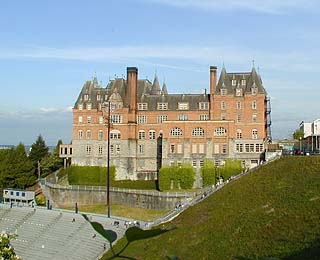
Photo courtesy of Merritt+Pardini Architects A sports bowl stadium, foreground, was added to Stadium High just a few years after it opened in 1906.
|
This balance means accommodating Stadium’s current student enrollment of almost 1,900 students within a 1906 building envelope intended for less than 900.
More space is critically needed: a larger gym and cafeteria, more classrooms, and completely new spaces such as a training room and commons area.
Circulation routes need to be redesigned as students on the upper floors who want to move between the north and south wings of the school currently have to descend to the first level, as the auditorium stretches east to west across the center of the second and third floors.
The modern curriculum, with its expanded range of educational services and activities, requires extensive technology upgrades and additions to provide fully computerized and wired classrooms, as well as adequate security surveillance.
Improvements to building systems such as HVAC and installing elevators will be necessary to meet current building codes that have stringent requirements for building integrity, accessibility and fire safety that were not issues at the school’s inception.
Bassetti Architects’ responsibilities include developing the educational specifications for the project, which will involve evaluating different, modern educational models.
‘Small schools’
One of these models, known as “small schools,” reorganizes a high school into smaller, self-contained units, each with no more than 450 students. It is currently being introduced at three other Tacoma high schools, including Mt. Tahoma, whose existing building will be used to house Stadium students while their school is being renovated.
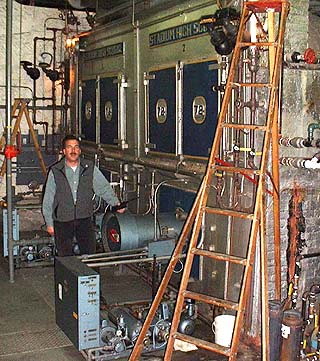
Photo courtesy of Merritt+Pardini Architects Stadium High Principal Jonathan Kellett stands by the original boilers in school’s sub-basement.
|
Under the small schools model, students stay in their assigned unit for the four years they attend high school, and each student has an adult mentor to assist with current and future school planning. Research has shown that this kind of relationship-building in smaller schools is a strong factor in reducing the high drop-out rate of students in grades 9 and 10.
The small schools model impacts how schools are designed as teachers in one department, i.e. the English department, will no longer be grouped together in one area of a school as they are now.
“Under this concept, the architect will need to build clusters of classrooms for all fields of study within each unit,” explains Loren McConachie of Bassetti Architects. “So as we develop the educational specifications, we will be evaluating with the school district the different classroom configurations and sizes not only of the small schools model but several others. The challenge will be to determine which model best fits Stadium’s existing floor plan and column and beam spacing.”
The renovation of Stadium High School is estimated to take five years to complete.
In Phase I, team members will conduct a building inventory and analysis, develop the educational programming and complete schematic design by summer 2002.
Design development will follow in Phase II. This high-profile project will be monitored and guided by a series of committees, including the Stadium Planning Committee and the Historic Advisory Committee.
The Stadium Planning Committee is composed of former and current Stadium principals and alumni groups, the PTA, and community representatives who will provide input to the school board and project team.
The Historic Advisory Committee’s members will be drawn from the Seattle and Tacoma landmarks preservation commissions, and local historical activists, and will provide oversight on historic elements of the building and act as liaison to the Tacoma Landmarks Preservation Commission. A historic conservator is being appointed as the facilitator.
“This committee structure will play an important role in the project’s development because of the members’ broad spectrum of experience,” says Lee Pardini. “In addition, because we are extremely sensitive to the historical significance of this facility to the community, we will also make presentations to the broader community to judge acceptance of the design.”
Construction is scheduled to begin in summer 2004, and is expected to last for two to three years. A contractor will be selected not by public bid, but under the general contractor/construction management arrangement. The project will be funded under a $450 million school construction bond issue.
Julie Highton handles public relations and urban planning at the Seattle and Tacoma offices of Merritt+Pardini.
Other Stories:
- A peek into the architectural process
- Achieving design certainty through collaboration
- Getting a project off the ground
- Head and shoulders above Sea-Tac
- High-rise homes with all the right stuff
- So you’re in it for the money
- What you need to know about your competitors
- Thea’s Landing: Downtown Tacoma’s new urban housing
- New museum will have Tacomans glassy-eyed
- Beyond the urban core: Learning from the pioneers
- Controlling stormwater the natural way
- A cap over troubled waters
- Orchestrating Belltown’s rebirth
- Mechanical moxie: Innovations at the new Opera House
- Preserving a church gets personal
- Small housing: A Northwest mini-trend
- Delivering the goods in a tight economy
- Don’t overlook moisture — the silent threat
- Designing a one-building ‘city’ on a Norwegian fjord
- The changing face of retail design
- Preserving affordable housing by design
- Hospitality industry draws on refuge and prospect
Copyright ©2009 Seattle Daily Journal and DJC.COM.
Comments? Questions? Contact us.